Speech Open Market Operations and Domestic Securities

Guy Debelle
[1]
Assistant Governor (Financial Markets)
Address to Australian Securitisation Forum
Sydney –
It is an interesting time to speak to this forum. The last few months have been a period where securitisation has come to the fore, for better or worse. It is not often that securitisation makes the front page of the newspaper, even the local area weekly in those councils who have held some CDOs.
My remarks today will be divided into two parts. I first will discuss the Reserve Bank's system for open markets operations. I will spend a little time reviewing the mechanics of the system before describing how it has operated during the recent period of turbulence in credit markets. Why is this relevant for a conference on securitisation? Part of the answer is that in September, the RBA extended the range of collateral that is eligible for its open market operations to include residential mortgage-backed securities (RMBS) and asset-backed commercial paper (ABCP). These changes to the RBA's operations may well affect the liquidity and attractiveness of these securities in the future. Another part of the answer is that securitisation has been at the centre of the turbulence in credit markets, the effects of which have been very evident in the dislocation in short-term money markets where central banks conduct their domestic market operations.
The second part of my speech will describe the state of play of securitisation in Australia. I will give a brief summary of the evolution of the securitisation market in this country and discuss some of the challenges currently facing the industry.
Framework for Open Market Operations[2]
But first, I will spend a little bit of time describing the system for open market operations in Australia. Normally, this would be of interest only to the true afficionados of central banking, but in the past few months, these operations have been an important element in responding to the turbulence in global financial markets.
The operational target for monetary policy in Australia is the overnight interest rate on unsecured loans between banks, known as the cash rate. The target for the cash rate is established at the monthly meetings of the Reserve Bank Board, currently it is 6.75 per cent. To keep the cash rate as close to this target as possible, the Domestic Markets Department of the Reserve Bank conducts operations in the cash market every day.
On a day by day basis, the cash rate is affected by the demand and supply of funds for exchange settlement (ES) funds. ES funds are held by the banks on deposit with the RBA to meet their settlement obligations to each other and to the RBA. ES balances must remain positive at all times, but the daily flows in and out of these accounts can be very large. The settlement of transactions between the banks affects the distribution of ES balances among the banks while the payment of tax revenue results in a large flow of funds from the ES accounts of the banks to the Australian Government's account which is held at the RBA. Government expenditure results in the opposite flow. Indeed any transaction involving the Australian Government, the RBA, or official institutions who hold an account at the RBA, will affect ES balances.
Each day, the Domestic Markets Department (DM) determines the likely size of these net flows and indicates its dealing intentions for the day to the market at 9.30 am. This announcement indicates whether the Bank is intending to supply funds to the market (as well as the preferred term to maturity for the dealing). Partly because the Australian Government has been running a budget surplus for a number of years, and partly reflecting the structure of the RBA's portfolio of domestic securities, more often than not, the Reserve Bank is acting to inject funds.
After this announcement, the DM dealing room then receives bids for funds from the banks. The banks indicate how much funds they would like, at what term, what collateral they will provide in exchange for those funds, and what price they are willing to pay for the funds. From this, the Reserve Bank is able to gauge the strength of demand for funds on a daily basis. To further enhance the information available to us, our domestic dealing room is in constant contact with the participants in the market.
This ability to assess the funding needs of the market on a daily basis is particularly important in times of stress, such as in recent months. Moreover, because of the Bank's flexibility in conducting operations at varying terms, the system is also well-placed to respond to pressure at particular horizons. In the most recent episode, the funding problems were particularly acute at longer terms, hence, as discussed further below, the Bank was able to help alleviate these pressures by conducting more repos at longer maturities.
With the bids lodged, the Bank then determines which of the bids it is willing to accept, to ensure that the aggregate level of exchange settlement balances is at the level we feel will ensure that the cash rate remains at the target rate. These operations are generally completed by around 10 am. Over the rest of the trading day, the banks exchange funds amongst themselves depending on which institution happens to have a surplus of funds and which happens to have a deficit. This is somewhat random depending upon the nature of the payments that take place in the community and on which banks' customers are the recipients of government spending or are paying tax. Nearly all of these inter-bank transactions occur at the cash rate, unless there is an unexpectedly large surplus of funds in the cash market, or an unexpected shortfall. On rare occasions, the Reserve Bank may also re-enter the market later in the day to inject or withdraw liquidity.
However, the number of times the cash rate deviates from the target has become very low. Table 1 shows that from July 2004 to June 2007, the cash rate only deviated from the target on three occasions.[3] Since July 2007, seven deviations have been recorded although each of these deviations has been no more than 1-2 basis points. In part, the prevalence of transactions at the cash rate reflects the fact that while a bank may be offering cash one day, it may be bidding for cash the next. Nevertheless, the few deviations recorded indicates the flexibility of the operating system to react to changing market circumstances and ensure that the policy rate determined by the Reserve Bank Board is not materially affected by developments in the money markets.
| Basis point deviations | ||||||
|---|---|---|---|---|---|---|
| −2 | −1 | 0 | 1 | 2 | 3 | |
| 2002/03 | 0 | 27 | 223 | 3 | 0 | 0 |
| 2003/04 | 0 | 0 | 250 | 5 | 0 | 0 |
| 2004/05 | 0 | 0 | 253 | 0 | 0 | 0 |
| 2005/06 | 0 | 0 | 253 | 0 | 0 | 0 |
| 2006/07 | 0 | 2 | 248 | 0 | 0 | 1 |
| 2007/08 | 1 | 6 | 99 | 0 | 0 | 0 |
In providing or withdrawing funds from the system, the Reserve Bank has a number of options. Firstly, it can buy or sell securities outright, which is the textbook description of open market operations. If the RBA buys a government security from a bank, the RBA credits the bank's ES account with the funds. The bank's ES balances rise as the RBA injects the cash. If the RBA sells a government security, the money is paid from the counterparty bank's ES account. Secondly, it can buy or sell a security under a repurchase agreement (‘repo’). This is similar to an outright sale except the transaction is reversed at an agreed time in the future. Thirdly it can engage in a foreign exchange swap. This can be most easily thought of as a repurchase agreement where the repurchase agreement is in foreign exchange rather than government securities. For example, the RBA can enter into a swap to buy foreign exchange from banks for Australian dollars, with an agreement to sell the foreign exchange back, at an agreed exchange rate, at a specified time in the future. The RBA pays for the foreign exchange by crediting a bank's ES account with Australian dollars (which increases aggregate ES balances). When the swap matures, the counterparty bank's repayment of Australian dollars to the RBA is effected by a debit to that bank's ES account (which reduces aggregate ES balances).
Graph 1 shows the changing composition of the RBA's market operations over the years. Until the middle of the 1980s, the RBA's open market operations were conducted exclusively through outright transactions in Commonwealth Government Securities (CGS). Through the 1990s, repurchase agreements became an increasingly important instrument. Then, as the Australian Government reduced the stock of outstanding government debt, the Bank increasingly used foreign exchange swaps to manage domestic liquidity, and since 2004, we have also used repos in bank bills. Otherwise, the Bank would have exacerbated the shortage of government collateral available in the domestic market.
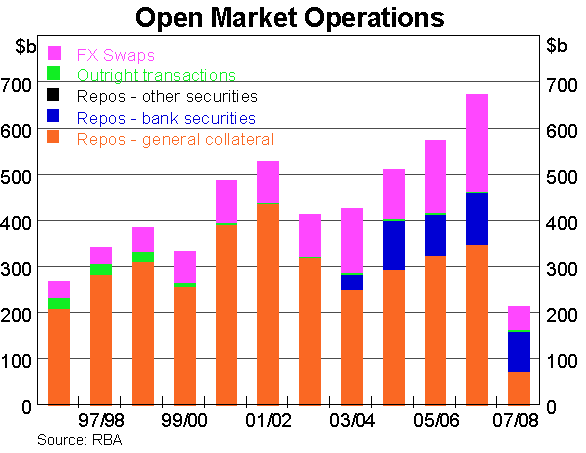
With the recent developments, there has been a marked shift in the nature of the Bank's operations away from foreign exchange swaps to repos in the domestic market, with bank paper as collateral. I will now describe these developments in more detail.
RBA's recent operations
The shock to money markets around the world in mid August, described in more detail in the November Statement on Monetary Policy, saw the demand for settlement funds rise sharply. The root cause of this dislocation was in a market where securitisation plays a major role: the sub-prime loan market in the US. The problems in this market are now well-documented. The transmission of these problems to other markets was related to both the securities containing these loans and the related CDOs, and the ABCP used to fund either investments in these securities or to fund warehouses of these loans prior to their securitisation.
As the pressures in these markets intensified, a number of developments occurred that all contributed to the pressure in short-term money markets. With the ABCP market drying up, financial vehicles (particularly, structured investment vehicles (SIVs)) that had funded long-term investments with short-term ABCP turned to their sponsoring banks for liquidity support. In addition, the banks themselves became more cautious and less willing to lend to each other, both because of the uncertainty surrounding the exposure of each institution to these problems, which is only now being slowly revealed, and because each institution was unsure the extent to which the lines of credit they had provided were going to be called upon. Moreover, other markets such as the primary issuance market for collateralised loan obligations virtually closed as investors shunned new issues, forcing banks to expand their own balance sheets and retain the loans they had originated but had been intending to package and sell to investors. The net result was that this additional demand for credit was not easily met and cash was at a premium.
These pressures in money markets intensified over August and September. 3-month interbank interest rates in Australia peaked at over 7 per cent in mid September, more than 50 basis points above the corresponding rate that measures expectations of the cash rate (the overnight indexed swap rate: OIS) (Graph 2). The spread prior to these developments had been around 5–8 basis points. In response to the increased demand for liquidity, the Reserve Bank injected additional funds through its open market operations to help money markets function as smoothly as possible. Most other central banks undertook similar operations in their own markets.
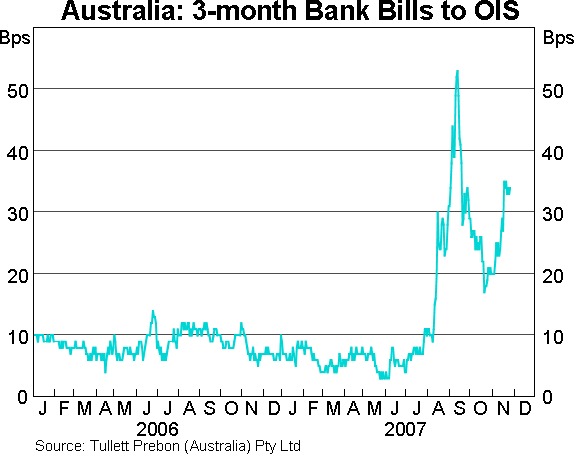
During this period, market participants' greater demand for liquidity was evident in the Bank's domestic market operations in several ways:
- there was an increased number of market participants bidding for cash;
- the bids were for larger amounts;
- participants were willing to pay more for that cash; and
- the bids were at longer term.
The Bank responded to this increased demand for cash by injecting a significant amount of funds into the market, resulting in a rise in ES balances. The aggregate balance of ES accounts rose as high as $5.5 billion on 23 August, compared with an average balance of around $750 million over recent years (Graph 3). Because demand was substantially greater, the bids at which the Bank conducted repos were higher than they had been, despite the larger injections of liquidity.
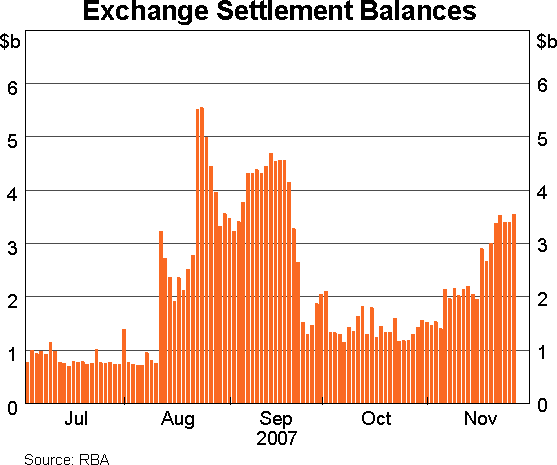
In response to pressures in the bank funding markets – particularly for longer term loans – the Bank altered its market operations in a couple of ways. The Bank conducted a greater share of its operations as repos collateralised by bank bills and certificates of deposit (CDs), with an offsetting decline in the share collateralised by government securities. The Bank also increased the maturities of the repos it conducted in response to the difficulties faced for longer term funding. As a result, the share of the Bank's holdings of bank bills and CDs in its domestic securities increased, from an average of around 40 per cent over the past year to around 85 per cent in early November (Graph 4). The maturity of the Bank's outstanding repos increased from an average of around 20 days to over 50 days by mid September, with a significant portion of the repos entered into in this period having terms extending beyond three months.
The bottom line is that the Bank met the increase in demand by increasing the supply. The success of this action can be gauged by the fact noted earlier that there were only a very few deviations of the daily cash rate from the target rate (Table 1). Moreover, these deviations were all on the downside reflecting an excess supply of cash, and were no more than two basis points, despite the markedly greater demand for cash which could have been expected to drive the price of cash up.
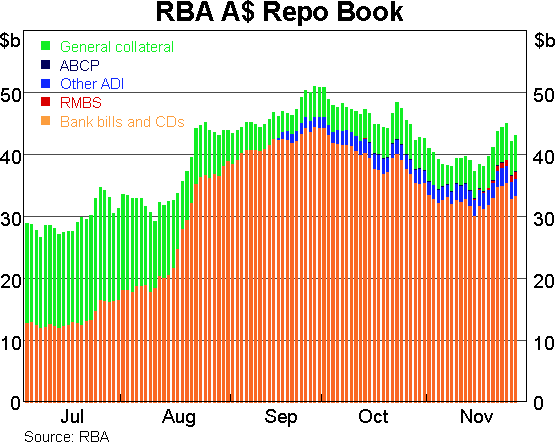
Over this period, the Bank also allowed its foreign exchange swaps to decline, both to facilitate an increase in the holdings of domestic securities and to accommodate changes in the size of the Bank's balance sheet. The Bank's foreign exchange swaps declined from just over $45 billion in early August to zero in November.[4]
As conditions in the money market improved through September and October, the Bank withdrew much of the liquidity it had injected. ES balances were around $1¼ billion in the early part of November. This was still higher than the average level before the recent turbulence, reflecting the desire of some financial institutions to operate with a higher level of cash balances than previously. Balances rose again in mid November as funding pressures re-emerged. These recent pressures have followed large write-downs by many global banks of their CDO exposures, along with year-end funding pressures.
Throughout the whole period, the Bank's actions in the money market have seen the cash rate remain very close to the target, deviating only very occasionally and by no more than two basis points.
The other major development in our operations during this period, which is probably of most interest to people in this room, was that in early September, the Reserve Bank broadened the range of securities that could be used for repo.[5] This represented the latest stage in the progressive broadening of the range of securities accepted for repos that has occurred over the past decade but its timing also provided an avenue for the Bank to assist the functioning of a broader range of markets.
The list of eligible Authorised Depost-taking Institution (ADI) issuers of bank bills and CDs was broadened and longer term securities issued by ADIs (with a high credit rating) were accepted for the first time. The Bank has also begun to accept both short- and long-term securities backed by residential mortgages – asset-backed commercial paper (ABCP) and residential mortgage-backed securities (RMBS) respectively – as collateral. As was previously the case, the Bank looks to ensure that the quality of the securities it accepts as collateral are not dependent upon the financial viability of the institution offering the securities to us – there is separation between who we deal with and whose securities we accept.
The Bank will accept all RMBS as collateral, however it will only provide value for prime full-doc residential insurable mortgages and similarly qualified low-doc mortgages comprising up to 10 per cent of the value of the security.
There were a number of reasons behind the decision to extend the pool of eligible collateral:
- Through the period of turbulence there has been a much larger premium placed on liquid assets. This was generating a distortion between different parts of banks' balance sheets and between different banks depending on their funding sources. Assets, which in other times would be treated similarly in the market, were being discriminated based on their repo-eligibility. The broadening of repo-eligibility sought to address one source of the distortion.
- As the dislocation was particularly prevalent in the securitised markets, the change sought to address the dislocation at its source rather than indirectly.
- The RBA had been accepting bank bills in its operations for a number of years, so it was a sensible progression to accept highly rated asset-backed paper sponsored by the same institutions.
- These securitised markets in Australia had become much more mature in recent years, a development which I will now discuss in more detail.
Before doing so, it is also worth noting that the RBA's current practice is in line with that at a number of other major central banks.
The securitisation market in Australia
Table 2 describes the current size of the Australian securitisation and bond market. Asset-backed securities (ABS) account for around one-fifth of non-government debt securities on issue. RMBS make up the majority of Australian ABS, accounting for around 60 per cent. ABCP is the next largest category (23 per cent), followed by CDOs (5 per cent) and commercial mortgage-backed securities (CMBS) which account for around 4 per cent. The remaining types of asset-backed securities are largely backed by leases, receivables and motor vehicle loans.
| A$ billion | |
|---|---|
| Financials | 858 |
| Non-financial corporates | 141 |
| Asset-backed securities | 276 |
| Of which: | |
| Residential mortgage-backed securities | 170 |
| Commercial mortgage-backed securities | 12 |
| CDOs | 15 |
| Asset-backed commercial paper | 64 |
| Of which: | |
| Residential mortgages(b) | 45 |
| Other(c) | 14 |
|
(a) Includes bonds issued onshore and offshore
Sources: ABS; RBA; S&P |
|
Australian RMBS outstanding has grown strongly over the past decade to stand at around $170 billion. The share of all housing loans that are securitised has increased to around 20 per cent from less than 5 per cent in the mid 90s (Graph 5). In part, this increase reflects the entry of mortgage originators who rely predominantly on securitisation for funding – they currently account for around 10 per cent of outstanding housing loans. Regional banks securitise a higher share of housing loans (around a third) than the major banks (less than 10 per cent).
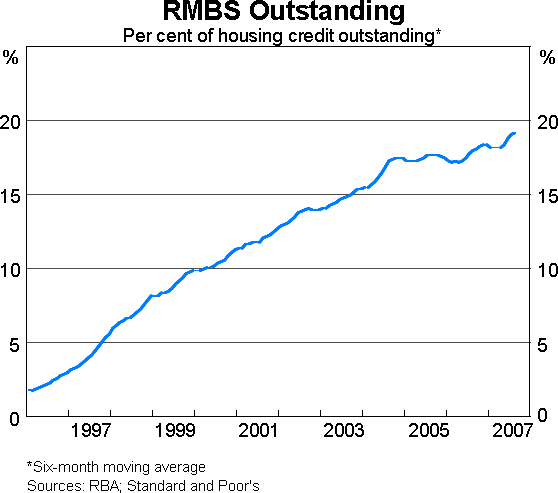
Prime RMBS make up the bulk of outstanding RMBS (96 per cent). Around 60 per cent of prime outstandings were issued offshore, with these securities mainly denominated in US$ and Euros (Graph 6). In contrast, almost all (around 90 per cent) non-conforming RMBS have been issued onshore.
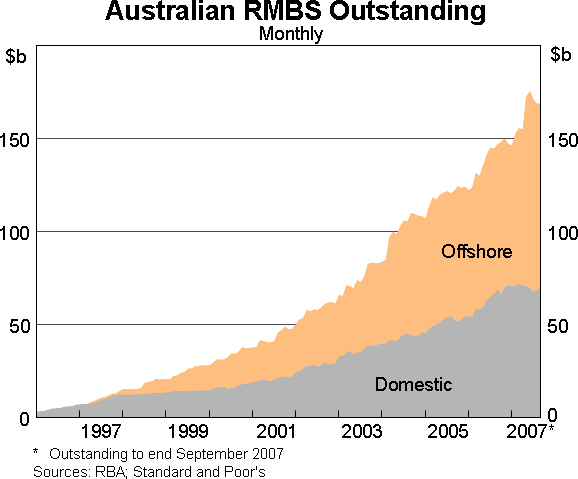
The Australian CDO market has grown extremely quickly over the past five years, rising sevenfold. As described in more detail in a recent article in the November RBA Bulletin,[6] Australian CDO issues are mostly backed by corporate debt, with corporate bonds and loans accounting for 57 per cent and 27 per cent respectively. The remaining 16 per cent of collateral consists of CDOs of ABS. This is a much smaller share than in the global market, where CDOs of ABS account for around 60 per cent. Australian debt makes up just under half of the collateral underlying domestic CDO exposure, with international credits making up the remainder. The quality of the collateral backing CDOs in Australia appears to be noticeably higher than in the US. At issuance, around 90 per cent of the bonds and loans in domestic CDOs were investment grade (rated BBB or above by S&P), with 10 per cent sub-investment grade or unrated.
| $ billion | Per cent of total | |
|---|---|---|
| Residential mortgages | 37.5 | 53 |
| Of which: Prime | 37.4 | 53 |
| Non-conforming | 0.1 | 0 |
| Residential mortgage-backed securities | 12.0 | 17 |
| Of which: Prime | 11.4 | 16 |
| Non-conforming | 0.6 | 1 |
| Auto/equipment loans & leases | 4.1 | 6 |
| Equities | 3.5 | 5 |
| Margin loans | 3.6 | 5 |
| Infrastructure bonds | 3.9 | 6 |
| Small business loans | 0.7 | 1 |
| Trade receivables | 1.2 | 2 |
| Commercial mortgage-backed securities | 0.1 | 0 |
| Collateralised debt obligations | 1.4 | 2 |
| Corporate bonds & loans | 0.4 | 1 |
| Credit card receivables | 0.5 | 1 |
| Other | 1.9 | 0 |
| Total | 70.8 | 100 |
|
*Underlying collateral is higher than outstanding ABCP due
to over-collateralisation Source: Standard & Poor's |
||
The ABCP market has grown by nearly 65 per cent over the past 3 years, from around $40 billion in 2004 to around $65 billion currently. Around two-thirds of the collateral backing Australian ABCP is residential mortgages (Table 3), though, excluding the 17 per cent that are RMBS, this only accounts for just under 4 per cent of the value of Australian housing loans. Over 80 per cent of the ABCP outstanding has been issued by multi-seller conduits. Prior to the recent turbulence, around half of the ABCP was issued offshore.
All of these securitisation markets have been affected by the turbulence. As has been the case overseas, conduits in Australia issuing asset-backed commercial paper (ABCP) have been among the entities most affected by the recent volatility in credit markets. In August and September, domestic conduits shifted much of their ABCP funding onshore, in response to the more difficult conditions offshore: data from Standard and Poor's (S&P) indicate that between July and September, ABCP outstanding onshore increased $10 billion (25 per cent), while offshore the amount outstanding fell $18 billion (55 per cent) (Graph 7). Overall, Australian ABCP outstanding – issued both onshore and offshore – fell by 11 per cent from end-July to end-September, compared to a decline of 25 per cent for US ABCP. Some Australian conduits called on their liquidity providers, although it appears that liquidity providers largely purchased ABCP rather than extending a loan. Liaison with market participants suggests that spreads on ABCP picked up sharply in August, as in the US, to be around 30–50 basis points above the bank bill rate relative to 2-5 basis points over recent years (Graph 8). Spreads have subsequently eased a little from the peak.
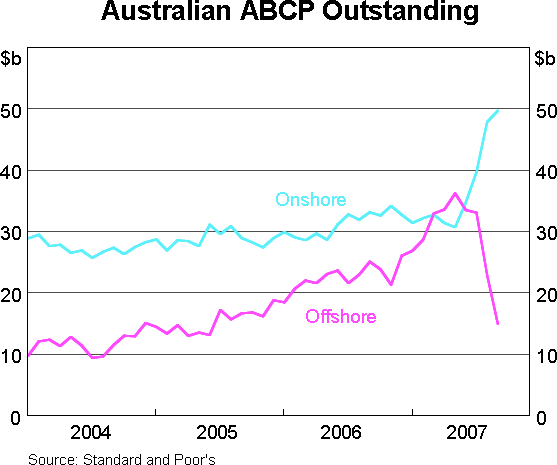
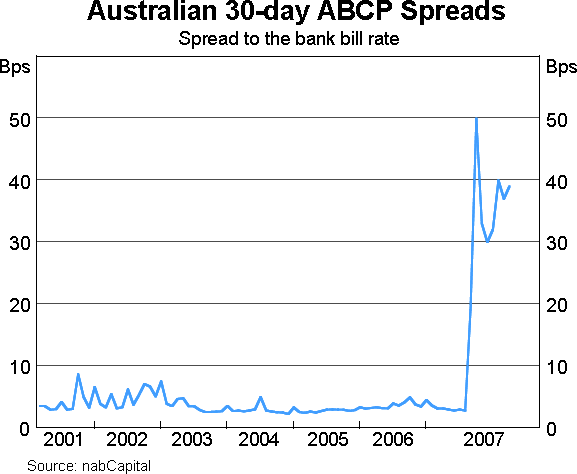
No RMBS issues took place in August. Two issues came to the market in September, six more were priced in October and two were priced in November, including the first non-conforming issue since March. Issues have been undertaken by both banks and mortgage originators (Table 4). It is noteworthy that the deals have tended to be small, though there are signs that investor demand may be strengthening with the size of several recent issues being increased prior to their completion. However, spreads on RMBS have widened substantially from the low levels in recent years, and are around levels last seen in 2003 (Graph 9).
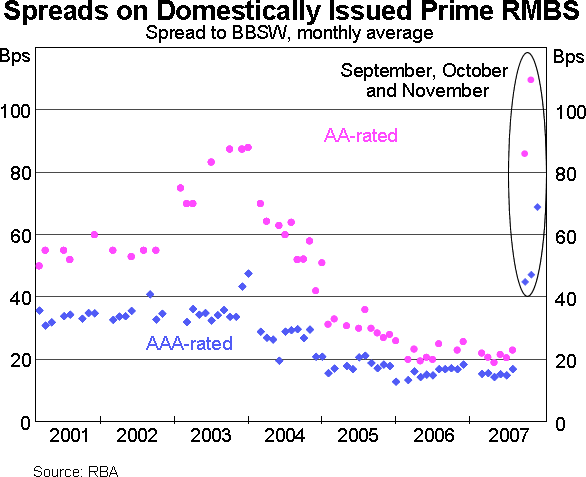
| Average LVR (Per cent) |
Share Low-doc (Per cent) |
Size ($ m) |
|
|---|---|---|---|
| September | |||
| Macquarie Bank | 67 | 0 | 500 |
| RAMS | 66 | 18 | 300 |
| October | |||
| Challenger | 70 | 38 | 298 |
| Calibre | 72 | 0 | 200 |
| First Mac | 76 | 0 | 250 |
| Adelaide Bank | 65 | 0 | 506 |
| Macquarie Bank | 59 | 100 | 350 |
| Bank of QLD | 62 | 0 | 350 |
| November | |||
| Columbus | 77 | 88 | 255 |
| Pepper | 73 | 68 | 200 |
| Average 2005 – July 2007 | 69 | 19 | 1617 |
|
Source: RBA |
|||
Private bond placements – for which details are often not publicly available – appear to be higher than usual. Reportedly, only half of the residential mortgage-backed securities (RMBS) that investors are reviewing are public issues.
Two auto securitisations have priced this month, albeit also at wide spreads. The most recent was upsized due to strong demand and included a foreign currency tranche; this was the first offshore ABS issuance since the turmoil in credit markets began. A CMBS was also issued in October.
There have been only a couple of CDOs issued in Australia since July. This is indicative of the global market where a total of around US$60 billion was issued in August, September and October, compared to a monthly average of US$50 billion prior to the turbulence.
Challenges for the securitisation industry
The recent developments pose a number of challenges for the securitisation industry.
In general, the growth of the securitisation market has enhanced the operation of the financial system. It has facilitated intermediation by enabling institutions to sell to a broader class of investor, rather than solely relying on intermediation across their own books. It has provided investors with a fixed interest product to meet their investment criteria.
In Australia, as in other countries, the growth of securitisation in the mortgage market in particular has significantly enhanced competition. As described in detail in other RBA publications,[7] it has allowed new entrants and contributed to lower margins.
However, the recent developments have generated a large amount of investor scepticism about securitised products. A lemons problem has arisen where all securitised products are being sold, albeit to varying degrees, at a discount because investors have become concerned about the product itself. The market will need to work to overcome this development by ensuring that there is sufficient information and transparency available to investors to enable them to differentiate between products appropriately. To some extent, the low yield environment of recent years probably contributed to some laziness on the part of investors. They failed to discriminate between securitised products and did not adequately question why one AAA-rated product was at a margin of 20 points over swap but another was trading at 100 points over.
Transparency is lacking on a number of fronts. Not enough is known in some cases about the pool of assets underlying the security. The absence of information about the price of the security has become problematic. The turnover of these securities has been extremely low thus precluding the establishment of an observable market price. This is true for RMBS, but particularly so for ABCP.
It is possible that the RBA's acceptance now of RMBS and ABCP as repo collateral may encourage the development of a broader repo market in these securities which would help reduce the uncertainty about repo pricing.
The RMBS market in Australia in particular, has used the presence of mortgage insurance as a prominent selling point. As you are all no doubt aware, there has been quite a lot of discussion in recent weeks about the mortgage insurance and bond insurance sector. So long as there is sufficient other credit enhancement such as subordination, mortgage insurance only affects the lower rated tranches of the RMBS, which in turn only account for a few percentage points of the value of an RMBS. Nevertheless, it will be interesting to see how the market responds to these concerns.
In theory, securitisation has allowed risk to be packaged and sold to meet the preferences of investors. However, the true nature and correlation of some of those risks has only become apparent to investors in recent months. The ‘originate and distribute’ model has seen the appropriate monitoring of the risks associated with the underlying loans fall through the cracks in some cases. These two factors might see a return to a greater reliance on intermediation for some time.
I see some analogous developments with the junk bond market. Junk bonds were the new thing in the late 1980s. The market grew rapidly and investors rushed to buy these high yielding instruments, in the end indiscriminately. The market crashed but it has now settled down to be an important, albeit smaller, part of the financial world. Securitisation, and CDOs in particular, are the “new new thing”.[8]
Endnotes
I thank my colleagues in the Domestic Markets Department for their help in preparing this speech, particularly Sue Black, Lindsay Boulton, Jonathan Kearns and Alan Rai. [1]
This draws on Box C in the recent Statement on Monetary Policy. More detailed information can be found on the RBA website. [2]
There were more than three transactions in the market at a rate other than the cash rate. The recorded cash rate is the weighted average rate of all the transactions that took place in the market on a given day. Daily turnover in the cash market is around $11 billion. The occasional transaction at a rate other than the cash rate will hence not have a significant impact on the weighted average rate. [3]
The decline in the fx swap book has had a material impact on the level of gross reserves. The standard definition of gross reserves includes all foreign currency assets, including those held under swap. As the swap book was run down, the measured level of gross reserves has declined from over A$80 billion to A$33 billion. However, the level of net reserves (where the swap book is netted off) has remained little changed. Net reserves are the relevant concept for assessing the Bank's capacity to intervene in the foreign exchange market. [4]
These changes were announced in a media release on 6 September 2007. Full details are available on the RBA's website. [5]
Black S and A Rai (2007), ‘Recent Developments in Collateralised Debt Obligations in Australia’, RBA Bulletin, November, pp 1–11. [6]
Ryan C and C Thompson (2007), ‘Risk and the Transformation of the Australian Financial System’, in C Kent and J Lawson (eds), The Stucture and Resilience of the Financial System, Proceedings of a Conference, Reserve Bank of Australia, Sydney, pp 38–75. [7]
It would seem appropriate to borrow a phrase from Michael Lewis in a speech on this topic. [8]